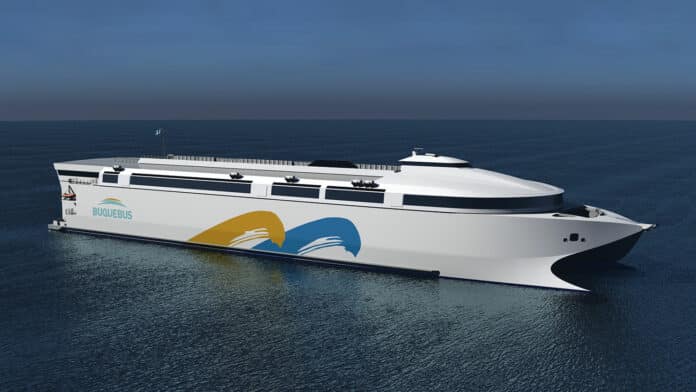Incat Tasmania, an Australian manufacturer of high-speed craft (HSC) ferries, is preparing to deliver the world’s first large, lightweight zero-emission ferry to Argentina-based operator Buquebus by 2025.
The zero-emission vessel will be 130 meters long and 32 meters wide. It will carry 2100 passengers and 226 vehicles at up to 25 knots for Incat’s long-term South American customers. Incat originally designed the zero-emission ferry to operate on an LNG power plant but is now working to replace the power plant with a battery-electric solution, as per Buquebus’s request.
“The customer wants this to happen, Incat wants this to happen, and whilst there are matters to be finalized, I am extremely confident that Incat can deliver this ground-breaking ship. In my experience, unless we see something come in from the left field, this is a done deal,” said Incat Group founder and chairman Robert Clifford.
“Obviously, there needs to be sufficient energy supply in the ports that the ship would visit, but we understand that this is progressing positively. The batteries and electric motors are being worked through with our suppliers to ensure they can deliver the technology required in the timeframe we need them,” he says.
There are always challenges if you change any aspect of the design of a ship part way through the build; in simple terms, this is just swapping one method of propulsion for another. It will, however, have significant environmental benefits and open up a whole new market for these types of vessels. The ship, which is to be delivered in 2025, when battery electric, would be the world’s largest, lightweight, zero emissions ferry operating on any route in the world.
“Delivering the world’s first large battery electric ferry for Buquebus would lead to exponential growth in the international market for large lightweight electric ships,” said Peter Gutwein, Former Tasmanian Premier and Incat’s Strategic Adviser. “The world wants large, lightweight zero-emission ships, and we are already scaling up our workforce and production facility in readiness for what will be a significant expansion.”
